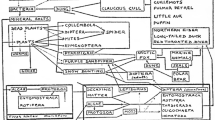Abstract
Comparison of the current approaches to human ecology shows a contradiction between certain views on the subject and the methodology of its analysis. The notion of human ecology as the ecology of the species Homo sapiens is being developed in terms of modern general ecology and should be considered at all organizational levels, from individual to global. Material and spiritual cultures, which are the main adaptations of human beings represent a continuation of the general trend of living matter towards progressive evolution and are accompanied by an increase in orderliness related to the intensification of energy consumption. This superindividual adaptation determines the human capacity for occupying new ecological niches without changing the hereditary background. Therefore, consideration of Homo sapiens at the superorganismal level is of special importance in human ecology. Analysis of this issue shows that the functional patterns of systems belonging to this level have certain characteristics in common with those of the population systems of other species.
Similar content being viewed by others
REFERENCES
Alekseev, V.P., Ocherki ekologii cheloveka (Studies in Human Ecology), Moscow: Nauka, 1993.
Bazykin, A.D., Matematicheskaya biofizika vzaimodeistvuyushchikh populyatsii (Mathematical Biophysics of Interacting Populations), Moscow: Nauka, 1985.
Beklemishev, V.N., Classification of Biocenological (Symphysiological) Connections, Byul. Mosk. O-va Ispyt. Prir., Otd. Biol., 1951, vol. 56, no.2, pp. 3–30.
Bolshakov, V.N. and Kryazhimskii, F.V., Ecology of Populations and Communities, in Our Fragile World. Challenges and Opportunities for Sustainable Development, Oxford: EOLSS Publishing Co., 2001, vol. 2, pp. 1313–1326.
Bol’shakov, V.N., Kryazhimskii, F.V., and Radchenko, T.A., Ecological Science and Ecological Philosophy, in Ekologicheskie issledovaniya na Urale (Ecological Studies in the Urals), Yekaterinburg: Ural. Gos. Univ., 1997, pp. 5–9.
Chetverikov, S.S., Some Moments of the Evolutionary Process from the Viewpoint of Modern Genetics, Byul. Mosk. O-va Ispyt. Prir., Otd. Biol., 1965, vol. 70, nos.4–6, pp. 171–176.
Chitty, D., Self-Regulation of Numbers through Changes in Viability, Cold Spring Harbor Symp. Quant. Biol., 1957, vol. 22, pp. 57–70.
Dol’nik, V.R., Energy Metabolism and Animal Evolution, Usp. Sovrem. Biol., 1968, vol. 66, no.5, pp. 276–293.
Dol’nik, V.R., Nerazumnoe ditya biosfery: Besedy o cheloveke v kompanii ptits i zverei (A Thoughtless Child of the Biosphere. Discussion about Human in a Company of Birds and Animals), Moscow: Pedagogika-Press, 1994.
Gorshkov, V.G., Fizicheskie i biologicheskie osnovy ustoichivosti zhizni (Physical and Biological Principles of Life Stability), Moscow: VINITI, 1995.
Gumilev, L.N., Etnogenez i biosfera Zemli (Ethnogenesis and the Earth’s Biosphere), Leningrad: Leningr. Gos. Univ., 1989.
Haeckel, E., Generelle Morphologie der Organismen, Berlin, 1866.
Ivlev, V.S., Experience in Assessing the Evolutionary Significance of the Levels of Energy Exchange, Zh. Obshch. Biol., 1959, vol. 20, no.1, pp. 94–103.
Hens, L., Human Ecology in Western Europe, Ekologiya, 1996, no. 3, pp. 171–176.
Krebs, C.J., A Review of Chitty Hypothesis of Population Regulation, Can. J. Zool., 1978, vol. 56, no.12, pp. 2463–2480.
Konoplev, V.A. and Zotin, A.I., The Criterion of Orderliness and Its Application to Some Evolution Problems, in Teoreticheskaya I Eksperimental’naya Biofizika (Theoretical and Experimental Biophysics), Kaliningrad, 1975, no. 2, pp. 98–108.
Kryazhimskii, F.V., Fitness or Biotic Regulation? Ekologiya, 1999, no. 2, pp. 114–115.
Kryazhimskii, F.V., Bol’shakov, V.N., and Koryukin, V.I., Man in the Light of Current Ecological Problems, Ekologiya, 2001, no. 6, pp. 403–408.
Lawrence, R.J., Human Ecology, Our Fragile World. Challenges and Opportunities for Sustainable Development, Oxford: EOLSS Publishing Co., 2001, vol. 1, pp. 675–693.
Lovelock, J.E., Gaia: A New Look at the Life on Earth, New York: Oxford Univ. Press, 1979.
Meadows, D.H., Meadows, D.L., Randers, J., and Behrens, W.W. III, Beyond the Limits, Kirkus Associates, L.P., 1992. Translated under the title Za predelami rosta, Moscow: Izd. gruppa Progress, Pangeya, 1994.
Odum, H.T., Biological Circuits and the Marine Ecosystems of Texas, in Pollution and Marine Biology, New York: Wiley, 1967.
Prokhorov, B.B., Ekologiya cheloveka: Ucheb. dlya stud. vyssh. ucheb. zaved (Human Ecology. A Textbook for the Students of Colleges and Universities), Moscow: Izd. Akademiya, 2003.
Reimers, N.F., Ekologiya (teorii, zakony, pravila, printsipy, gipotezy) (Ecology: Theories, Laws, Rules, Principles, and Hypotheses), Moscow: Zh. Rossiya Molodaya, 1994.
Schrodinger, E., What Is Life? Physical Aspects of the Living Cell, Cambridge: Cambridge Univ. Press, 1945, p. 91.
Severtsov, A.N., Glavnye napravleniya evolyutsionnogo protsessa. Progress, regress i adaptatsii (Main Directions of the Evolutionary Process: Progress, Regress, and Adaptations), Moscow: Izd. Dumnova, 1925.
Shilov, I.A., Biosphere, Levels of Life Organization, and Problems in Ecology, Ekologiya, 1981, no. 1, pp. 5–11.
Shnol’, S.E., Fiziko-khimicheskie faktory biologicheskoi evolutsii (Physicochemical Factors of Biological Evolution), Moscow: Nauka, 1979.
Shvarts, S.S., Population Structure of Species, Zool. Zh., 1967, vol. 46, no.10, pp. 1456–1469.
Shvarts, S.S., Population Structure of Biogeocenosis, Izv. Akad. Nauk SSSR, Ser. Biol., 1971, vol. 28, no.4, pp. 485–493.
Shvarts, S.S., Problems in Human Ecology, Vopr. Filosofii, 1974, no. 5, pp. 102–110.
Shvarts, S.S., Problems in Human Ecology, Vestn. Akad. Nauk SSSR, 1976, no. 12, pp. 80–89.
Stearns, S.C., The Evolution of Life Histories, Oxford: Oxford Univ. Press, 1992.
Timofeeff-Ressovsky, N.V., Yablokov, A.V., and Glotov, N.V., Ocherk ucheniya o populyatsii (An Essay on the Population Theory), Moscow: Nauka, 1973.
Vernadsky, V.I., Zhivoe veshchestvo (Living Matter), Moscow: Nauka, 1978.
Watson, J. D., The Double Helix, New York: The New American Library, 1968. Translated under the title Dvoinaya spiral’, Moscow: Mir, 1969.
Zotin, A.I. and Lamprecht, I., Aspects of Bioenergetics and Civilization, J. Theor. Biol., 1996, vol. 180, no.2, pp. 207–214.
Zotin, A.I. and Zotin, A.A., Napravlenie, skorost’ i mekhanizmy progressivnoi evolyutsii. Termodinamicheskie i eksperimental’nye osnovy (Direction, Rate, and Mechanisms of Progressive Evolution. Thermodynamic and Experimental Principles), Moscow: Nauka, 1999.
Author information
Authors and Affiliations
Additional information
__________
Translated from Ekologiya, No. 3, 2005, pp. 163–170.
Original Russian Text Copyright © 2005 by Kryazhimskii, Bolshakov.
Rights and permissions
About this article
Cite this article
Kryazhimskii, F.V., Bolshakov, V.N. Superorganismal Systems in Human Ecology. Russ J Ecol 36, 143–149 (2005). https://doi.org/10.1007/s11184-005-0052-8
Received:
Issue Date:
DOI: https://doi.org/10.1007/s11184-005-0052-8




